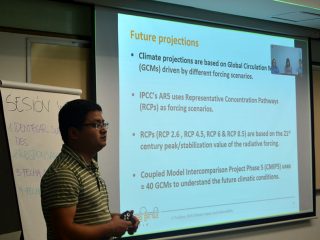
From the 1st to the 3rd of March, the participants of the project Sustainable Amazonian Landscapes (SAL) met in CIAT with the aim of reviewing the activities and advances achieved thus far in the project, as well as plan the activities for the year 2016.
During this occasion, we enjoyed the presence and active participation of our colleagues from the Instituto de Investigaciones de la Amazonía Peruana, the Universidad de La Molina, CIPAV, the Instituto Sinchi, the Instituto de Potsdam para la Investigación del Impacto Climático, and the Universidad de la Amazonía.
We dedicated the year of 2015 to understanding the context within our study areas of Yurimaguas (Peru) and Caqueta (Colombia). With this aim, we carried out rural participatory workshops, where the agricultural producers within the study sites provided information about their strategies for responding to climate change, their background stories, their relationships with their surroundings, and the value that they give to the natural resources around them.
In addition, we spent the year gathering samples of soils and associated macrofauna, which will allow us to understand the soil health, how it changes based on land covers and, above all else, will help us understand how agro-silvo-pastoral systems contribute to recuperating and rehabilitating soils.
Additionally, we began planting the Garden of forages, a space dedicated to evaluating the performance of forages and shrubs that are useful under the environmental conditions of Caqueta, as well as a space where the local farmers can become familiar with these types of vegetative materials. Finally, we validated, in the field, the ability of the Terra-i system to detect land use changes, through an intensive trip in Yurimaguas, in which we were able to verify a pattern of accelerated deforestation along the newly paved highways and secondary roads.
During the conference we also welcomed the presence of the Ambassador of Colombia in Germany (also an ex-Minister of the Environment), Juan Mayr, who shared his time and knowledge with students from the Universidad de la Amazonía, who were also participating in the meeting.
Embajador Juan Mayr habla #biodiversidad y economía de #Colombia con estudiantes de @uniamazonia @CIAT_ @iki_bmub pic.twitter.com/DVfSkAlOXb
— Andy Jarvis (@ajarviscali) March 2, 2016
Translation: Ambassador Juan Mayr talks #biodiversidad and economics of Colombia with students from @uniamazonia
2016 is a crucial year for our project, since both our presence and our work in the field will increase. We will be working side by side with our partners and farmers on the design and implementation of sustainable production systems in both countries. We hope to bring our implementations to around 90 hectares in each country, which will allow us to evaluate the contributions of this work towards climate change adaptation, ecosystem services provisioning, and the well-being of local communities.Likewise, we will continue developing our methodology for evaluating the impact of systems more sustainable at a landscape level and how these systems, in turn, can contribute to different pathways of sustainable development at the national level.
We hope to bring these implementations to around 90 hectares in each country where we currently work.
This work has been carried out as part of the project “Sustainable Amazonian Landscapes”. This project is a part of the International Climate Initiative (IKI). The Federal Ministry for the Environment, Nature Conservation, Building and Nuclear Safety (BMUB) of the Government of Germany (note that acronyms are from the original titles in German) finances this initiative based on the decision adopted by the German Bundestag. The project is lead by CIAT and implemented together with the Potsdam Institute for Climate Impact Research (PIK), the Centro para la Investigación en Sistemas Sostenibles de Producción Agropecuaria (CIPAV), Instituto Amazónico de Investigaciones Científicas SINCHI, Universidad de la Amazonía, Instituto de Investigaciones de la Amazonía Peruana (IIAP), and the Universidad Nacional Agraria La Molina (UNALM).










